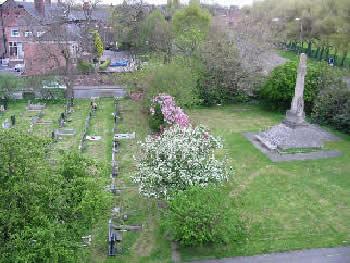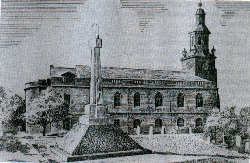ABOUT US
At Holy Trinity Wavertree we
come together to worship God,
the Father, Son and Holy Spirit
and to serve the people of
this parish with joy,
hope and love.
Find Us
Holy Trinity Church, Wavertree is situated in Church Road, Liverpool L15, at the junction of Church Road, Fir Lane and Woolton Road.
From Picton Road
Head to Picton Clock Tower. At the Clock Tower roundabout, turn right into Church Road. Holy Trinity is immediately on the right through the first set of traffic lights.
From M62
Turn left just past the Rocket pub (on the left) just before the traffic lights at the end of the Motorway. The slip road you are on merges with Liverpool's inner ring road, Queens Drive. Head straight through the first set of traffic lights. At the roundabout (known as Childwall fiveways - there are five exits), take the third exit to stay on Queens Drive. At the next set of traffic lights, turn right into Woolton Road. Follow Woolton Road to the next set of traffic lights. This is the junction with Church Road and you will see Holy Trinity diagonally left.
From Allerton Road
Head towards Penny Lane. At the end of Allerton Road there are traffic lights with the, now closed, Sergeant Peppers snack bar on the right. Turn right and follow the road around to the left. This is Church Road and Holy Trinity is on the left just before the next set of traffic lights.
HTW's Churchyard
The churchyard at Holy Trinity dates back as far as the church - over 200 years, though originally the site was only a fraction of the land it now covers (see history below). It contains a great number of graves and so much history; the church often deals with enquiries from people researching their family genealogy. Since April 1st 2002 the churchyard has been maintained by Liverpool City Council, and individual graves are tended by the families concerned. It is a ‘closed’ graveyard - in other words, it is full, with no room for new graves to be opened. Occasionally families can bury their loved ones in existing graves if there is room to do so. Increasingly their best option is to bury ashes. 
Unfortunately many of the church’s records were destroyed in a fire in 1961 but those that exist are held either by the church (more recent records) or the Records Office at Liverpool Central Library, William Brown Street, Liverpool L3 8EW. The Liverpool Diocesan office, Church House, 1 Hanover Street, Liverpool L1 3DW may also be of assistance with historical enquiries.
HTW's History
We are indebted to James H. Schroeder, author of the book The Life and Times of Wavertree Parish Church of The Holy Trinity 1794 - 1994, from which, with his kind permission, much of the material in this section of the website has been taken. It makes fascinating reading for those interested in the history of the Church. It is not possible to produce an entire and detailed history of the Church here. We hope you will find the information in the sections below to be of interest:
Wavertree in the 1700's
In prehistoric times there must have been a settlement in Wavertree as a burial site was found in Victoria Park some 150 years ago, during excavation work for the building of new houses. The Village of Wavertree is one of the oldest villages in the neighbourhood of Liverpool. Reference to it is found in the Doomsday Book and at the time of the Norman Conquest it was variously called "Vauretea", "Wa've", "Wavre" and "wartree". Wavertree did not grow very quickly at first. In 1731 there were only 50 houses. 60 years later there were 800 houses. When Holy Trinity Church was built (1794), Wavertree was described as "a pretty village pleasantly situated on a sandstone ridge about 200 feet above sea level, forming an agreeable contrast to the sea aspects of Liverpool". Life was very primitive. Coal gas was not available. Electricity had not been discovered. Candles and oil lamps provided light. Transport was by horse. Most men worked on the land. Most women worked in their parents homes or were housewives. Crime was rare. Obviously, Wavertree today is a totally different place, being an integral part of Liverpool's suburbs. If you wish to find out more about Wavertree's history or modern day Wavertree try visiting the Wavertree Society web site.
Holy Trinity Church - The Beginning
In the 1700's Wavertree village appeared to have everything except for a church. Folks wishing to attend church would have had to travel to Childwall Parish Church over a mile away. In 1793 land was acquired by a group of local gentlemen and merchants and in 1794, with the agreement of the Bishop of Chester, the Wavertree Chapel at Ease to Childwall Church was built, designed by John Hope. On 5th August 1794 the Bishop, the Very Reverend William Cleaver, consecrated the building, dedicating it to "The Holy Trinity".

Holy Trinity Becomes a Parish
In 1867 the Ecclesiastical Commissioners for England declared the District Chapelry of the Holy Trinity, Wavertree should be deemed a RECTORY. In that same year Holy Trinity Church opened a school in Cow Lane to meet the need for better education in Wavertree.
Early Significant Events Until the 1920s
In 1872, St. Bridget's Church in Bagot Street was consecrated as a Chapel at Ease to Holy Trinity (St. Bridget's was created a Parish in 1901). In 1883, a Gas supply was installed for lighting. In 1903, two benefactors gave surrounding land to the church so expanding the, up till then, small churchyard. In 1911 the church closed for substantial alterations, pews were substantially rearranged, balconies removed and a new organ installed. Electricity was installed. The east end Chancel of the Church was remodelled in "neo-grec" style by Charles Reilly, a friend of the rector at the time, and Professor of Architecture at Liverpool University. The late sir John Betjeman subsequently described Holy Trinity Church, Wavertree, as "Liverpool's best Georgian Church". In 1920 a War Memorial was erected and consecrated in remembrance of those who laid down their lives in the 1914-1918 conflict. In 1927, the Church Council decided that alternative accommodation was required for meetings which had been held at the Rectory until then. A plot of land opposite the church was obtained and the Institute (Church Hall) was built.

To Modern Times
In 1932, the PCC negotiated the purchase of additional land between the existing Churchyard and Prince Alfred Road. This increased the area of the Churchyard by over a third.
A New Rectory
The present Rectory was built in 1951 on land which had been the old Rectory's vegetable garden . The old building was deemed to be too large and in need of much renovation (according to records it was still Gas lit in 1947) and was sold to a Methodist Group then subsequently resold to an Independent Hebrew Congregation.
The End of the Church Tower
In 1953, the Church Tower, which had originally contained two Bells, was inspected and found unsafe. The City Surveyor blamed inherent structural weakness aggravated by the effects of bombing during the war. It was taken down.
Today's Threat
It's a sad reflection on recent society that having survived the war without apparent harm (until the discovery of the damage to the Tower) the biggest threat to Holy Trinity in recent years has been local vandals. In early 1961, a fire caused serious damage to Holy Trinity. The cause was never found but vandals were suspected. Fortunately, the Church was soon renovated. In 1971, another serious fire, started in the Churchyard by intruders, caused major damage to the building and destroyed the organ. The Chancel required major renovation and the whole building required redecorating. There are records of substantial vandalism in the Churchyard at this time and a couple of years later, during which much damage was done to headstones. Sadly, such vandalism re-occurred as recently as 2001.
The Present
As you look through the pages on this web site you will see that Holy Trinity Church Wavertree today represents a vibrant society with a multitude of diverse activities and opportunities to cater for many peoples needs in the local community, as well as helping those not so fortunate through charitable giving. In 1994 the Church celebrated its bi-centenary. Long may Holy Trinity Church Wavertree continue to exist, thrive and provide as it has in the past.